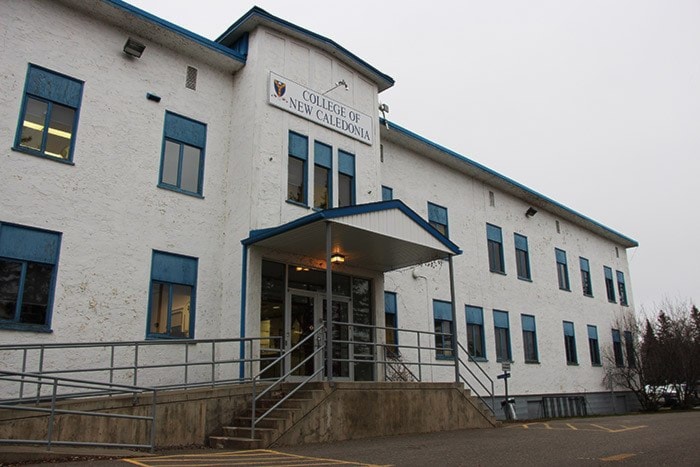Previously a number-one priority for the College of New Caledonia, a new and expanded building for CNC’s Vanderhoof campus is now fourth place on its list due to missing learner demand, the president says.
In a community meeting attended by close to 50 Vanderhoof community members, CNC’s president Henry Reiser, along with five other senior executives, provided an update on the college’s restructuring process in the face of a $2.8 million budget shortfall at Nechako Valley Secondary’s Integris Community Theatre on Nov. 10 evening.
Reiser said the change in priorities was decided by CNC’s executives and board, and though the Vanderhoof project was number one for several years, the government had denied it.
“We, as an institution, do not have the funds,” he said. “Bottom line is that the government will not invest where the numbers do not warrant.”
Reiser added, “That message has been made clear by the minister and the premier.”
In place of a new complex, CNC is open to leasing currently available space in town for its programs, as suggested by Vanderhoof’s mayor, but the college cannot commit until approval by the government — a decision based on demand, Reiser said.
For several of the meeting’s attendees however, including Vanderhoof Mayor Gerry Thiessen and staff from CNC’s Vanderhoof campus, the measured learner demand is a chicken-and-egg concept — the existing supply of courses limited the number of students in Vanderhoof.
“We as a community are receiving much less course offerings than other communities around us, and we’re substantially larger than Mackenzie, Fort St. James, and Burns Lake,” Thiessen said. “At some point, there has to be an offering of consistent education in our area.”
Vanderhoof’s high school students currently interested in trades would not look to CNC in Vanderhoof as a local college that could meet their needs, he added.
“It is extremely unfair to the residents of Vanderhoof and to the communities around us, First Nation and non-First Nation, who rely on the courses,” Thiessen said.
Prepared for CNC in 2012 and commissioned by the Nechako Valley Post-Secondary Education Committee led by Thiessen, a report on Vanderhoof’s post-secondary needs had shown a need for larger post-secondary presence, as enrolment is expected to double these years with the growth of the mining sector, as well as the development of major transportation and energy projects in northern B.C.
For its Blackwater Project located 110 km southwest of Vanderhoof, mining company New Gold recently announced an estimated construction start in early 2018, hiring 1,200 to 1,500 workers over a two-and-a-half-year period and 500 during the mine’s operation.
More community engagement to come
Reiser said he will commit, as the president, to ensure the effectiveness of the college’s community engagement, as meeting attendees expressed doubt on CNC’s knowledge of Vanderhoof’s needs.
The president had announced the college’s local trade program focus for the next three years, contingent on approval from the Industry Training Authority to be on carpentry in 2016/17, millwright in 2017/18, and piping foundation in 2018/19.
Councillor Brian Frenkel referenced New Gold’s projection of future jobs at the Blackwater Project —truck driving is identified as the highest hiring need — while a local CNC staff questioned Vanderhoof’s representation at the senior level in the college.
Scott Zayac, regional principal of Lakes/Nechako, said the college is currently hiring a deputy regional principal and a campus supervisor to be stationed at Fort St. James and Vanderhoof.
The college’s Burns Lake, Fort St. James, and Vanderhoof campuses were amalgamated into the Lakes/Nechako region earlier this year.
“If [the community] is not feeling engaged in that process, we’ll need to readdress that process itself,” Reiser said. “And I commit to that.”
As part of its restructuring process, CNC will have 30 site visits this winter to gather community input for the development of a five-year strategic plan, an education plan, as well as an aboriginal plan — with drafts of the strategic and education plans ready by next March, Reiser said.
To address the inconsistencies in delivery that he noticed in different campuses since the start of his presidency last year, Reiser said the college is looking to standardize programs and services for students and employees across the region — for example, the lack of a red-carpet and academic-gown convocation for students outside of Prince George.
As part of its action plan for 2015-16, the college is looking to expand its course offerings through the Digital Delivery Initiative, which would employ teleconference technology likened to the model that is used for medical consultations in rural communities, Reiser said.
For Mayor Thiessen, the college’s engagement with Vanderhoof has undergone a change in mindset since the CNC’s previous president John Bowman stepped down in 2013.
The former president had met with the Nechako Valley Post-Secondary Education Committee monthly to understand the needs of the community, Thiessen said.
“We don’t have an option,” he said. “If we’re going to stay viable as a community, we have to work very hard with the government to make sure that we have access to post-secondary education, especially in the area of trades.”
